Analysis of Business Performance and Risk Management at L&G
VerifiedAdded on 2022/08/29
|13
|4304
|10
Report
AI Summary
This report provides a detailed analysis of Legal & General Group PLC's business performance within the competitive financial services market. It begins with a brief overview of L&G, a multinational company offering life insurance, general insurance, investment management, and mortgage services, and its historical context. The report then delves into how business performance is measured, emphasizing the use of Key Performance Indicators (KPIs) and the Balanced Scorecard to assess strategic performance. It outlines specific metrics used for sales, finance, customer service, and departments, as well as the organization's capacity. Furthermore, the report examines the role of appropriate risk management techniques, including identifying and analyzing various risks such as economic, operational, and competitive risks. It discusses quantitative and qualitative risk analysis methods and their application within L&G. The report concludes by highlighting the importance of proactive risk management, considering both current and future market trends, and the need for adaptability in the face of economic pressures.
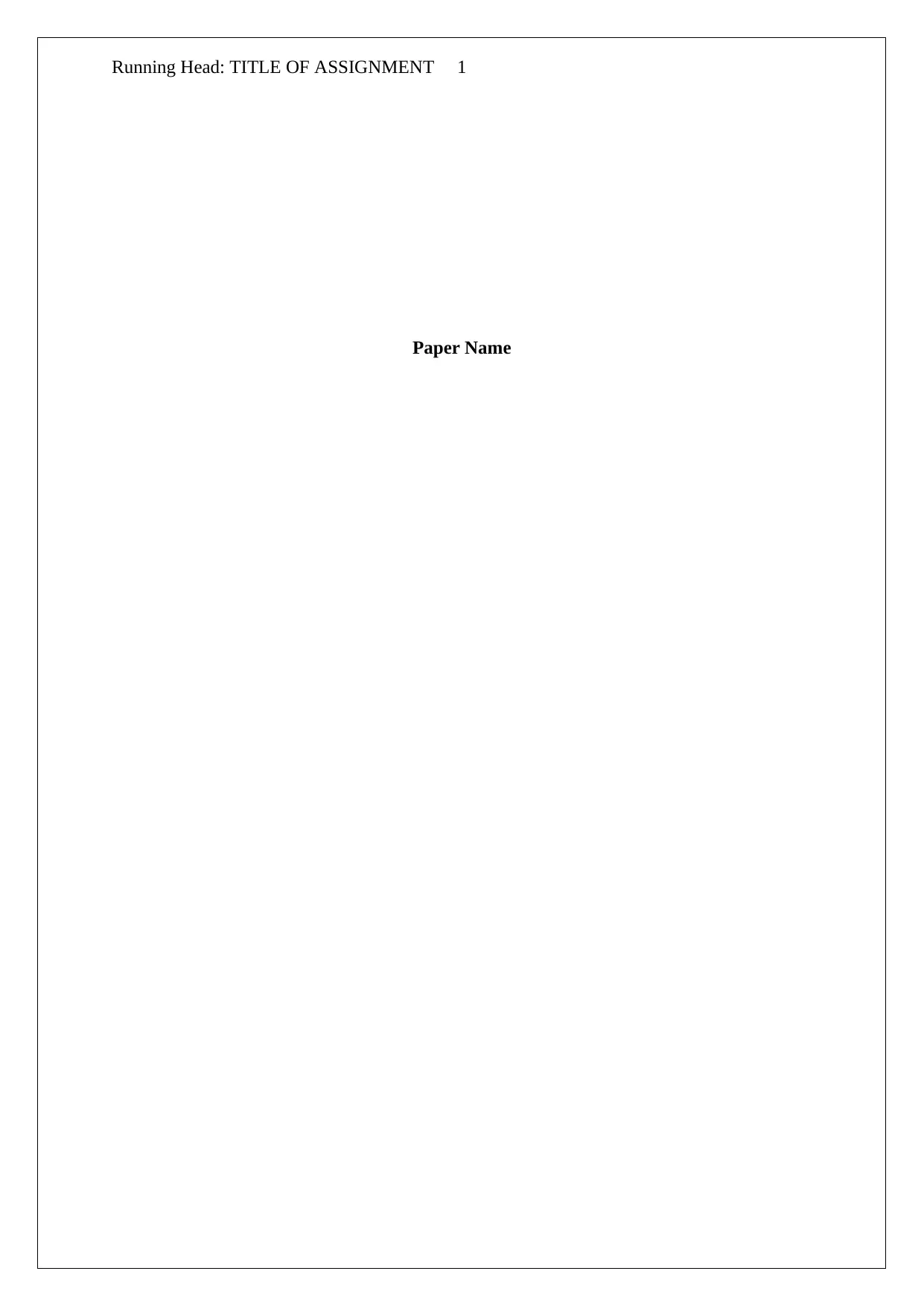
Running Head: TITLE OF ASSIGNMENT 1
Paper Name
Paper Name
Paraphrase This Document
Need a fresh take? Get an instant paraphrase of this document with our AI Paraphraser
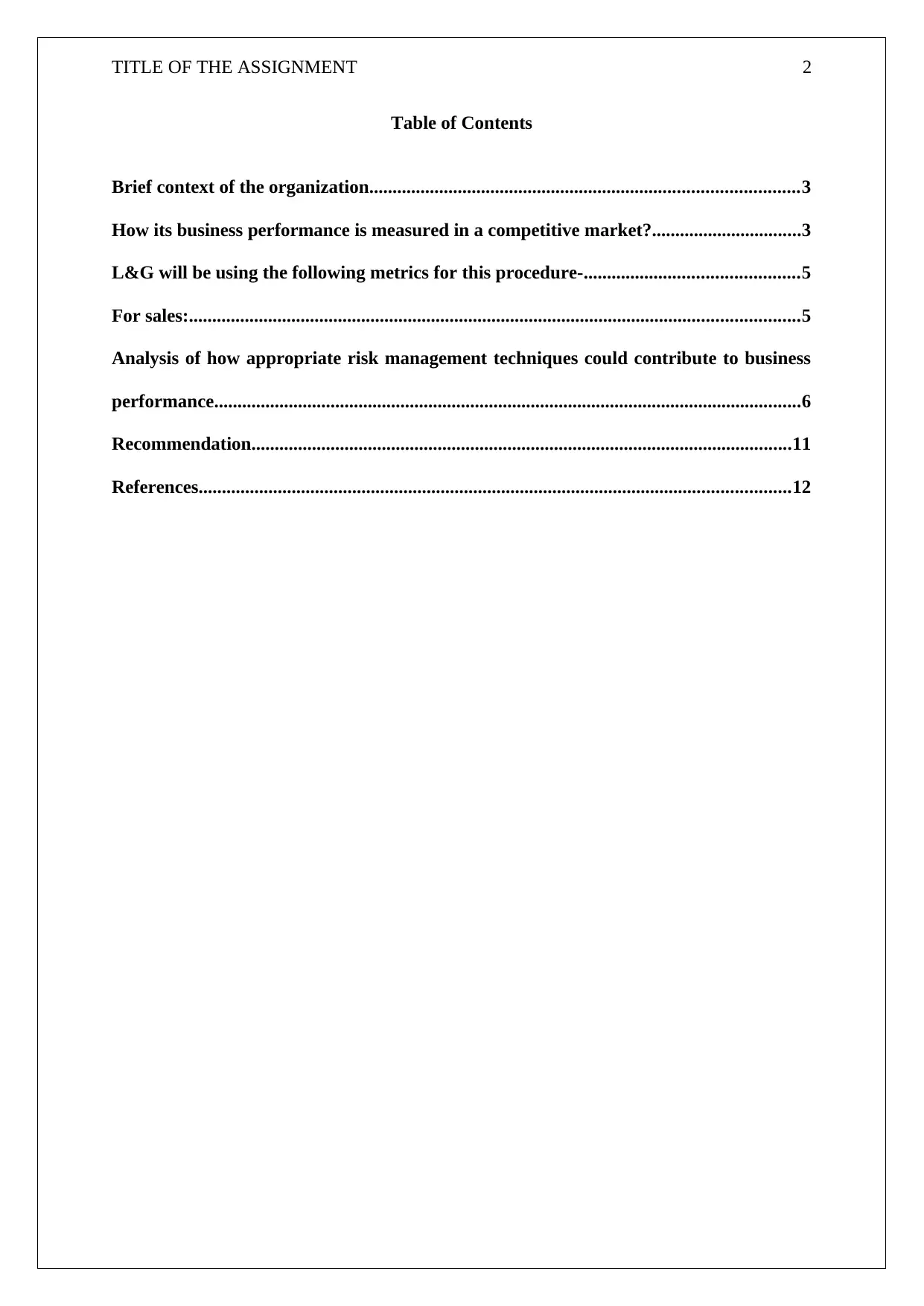
TITLE OF THE ASSIGNMENT 2
Table of Contents
Brief context of the organization............................................................................................3
How its business performance is measured in a competitive market?................................3
L&G will be using the following metrics for this procedure-..............................................5
For sales:...................................................................................................................................5
Analysis of how appropriate risk management techniques could contribute to business
performance..............................................................................................................................6
Recommendation....................................................................................................................11
References...............................................................................................................................12
Table of Contents
Brief context of the organization............................................................................................3
How its business performance is measured in a competitive market?................................3
L&G will be using the following metrics for this procedure-..............................................5
For sales:...................................................................................................................................5
Analysis of how appropriate risk management techniques could contribute to business
performance..............................................................................................................................6
Recommendation....................................................................................................................11
References...............................................................................................................................12
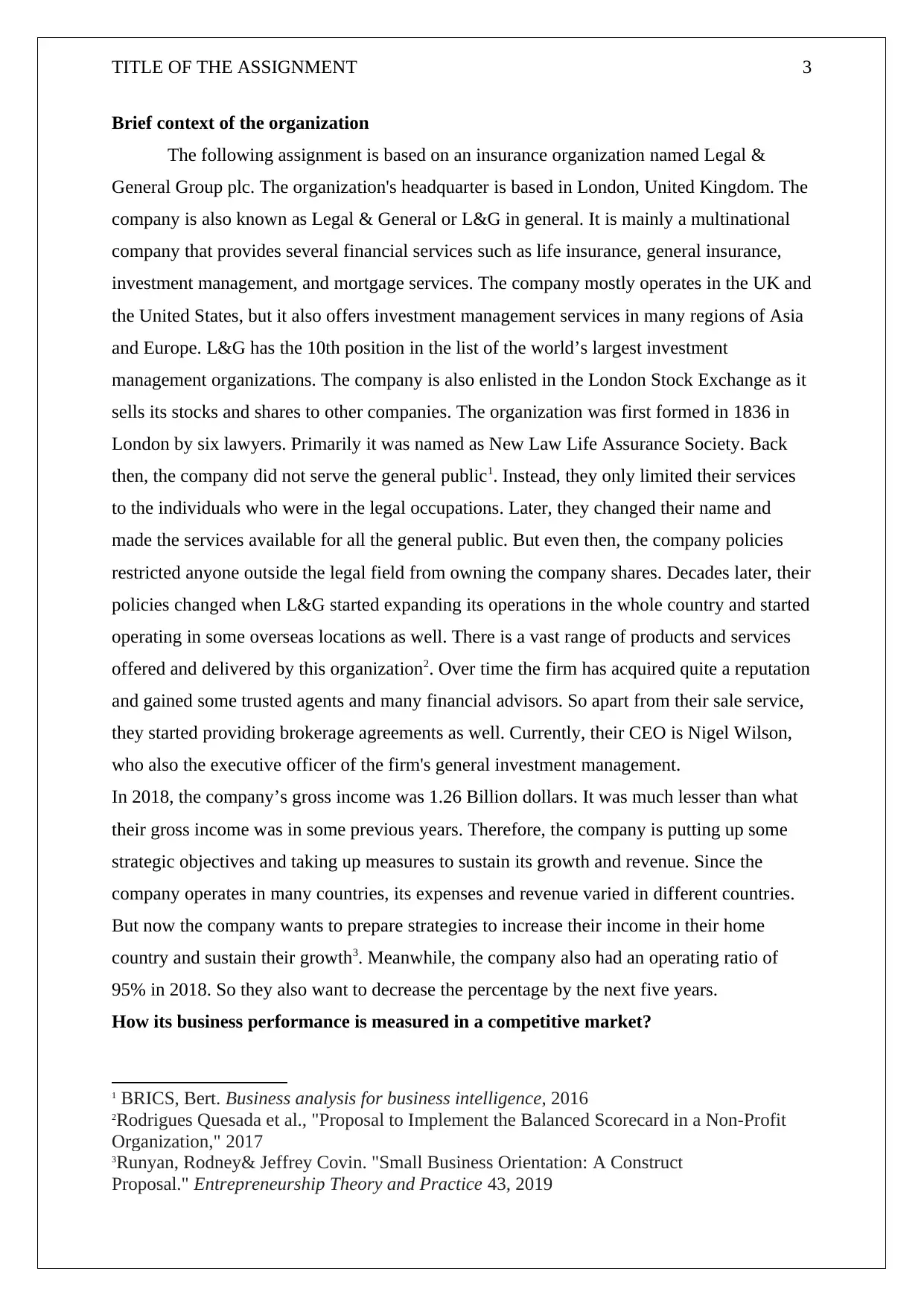
TITLE OF THE ASSIGNMENT 3
Brief context of the organization
The following assignment is based on an insurance organization named Legal &
General Group plc. The organization's headquarter is based in London, United Kingdom. The
company is also known as Legal & General or L&G in general. It is mainly a multinational
company that provides several financial services such as life insurance, general insurance,
investment management, and mortgage services. The company mostly operates in the UK and
the United States, but it also offers investment management services in many regions of Asia
and Europe. L&G has the 10th position in the list of the world’s largest investment
management organizations. The company is also enlisted in the London Stock Exchange as it
sells its stocks and shares to other companies. The organization was first formed in 1836 in
London by six lawyers. Primarily it was named as New Law Life Assurance Society. Back
then, the company did not serve the general public1. Instead, they only limited their services
to the individuals who were in the legal occupations. Later, they changed their name and
made the services available for all the general public. But even then, the company policies
restricted anyone outside the legal field from owning the company shares. Decades later, their
policies changed when L&G started expanding its operations in the whole country and started
operating in some overseas locations as well. There is a vast range of products and services
offered and delivered by this organization2. Over time the firm has acquired quite a reputation
and gained some trusted agents and many financial advisors. So apart from their sale service,
they started providing brokerage agreements as well. Currently, their CEO is Nigel Wilson,
who also the executive officer of the firm's general investment management.
In 2018, the company’s gross income was 1.26 Billion dollars. It was much lesser than what
their gross income was in some previous years. Therefore, the company is putting up some
strategic objectives and taking up measures to sustain its growth and revenue. Since the
company operates in many countries, its expenses and revenue varied in different countries.
But now the company wants to prepare strategies to increase their income in their home
country and sustain their growth3. Meanwhile, the company also had an operating ratio of
95% in 2018. So they also want to decrease the percentage by the next five years.
How its business performance is measured in a competitive market?
1 BRICS, Bert. Business analysis for business intelligence, 2016
2Rodrigues Quesada et al., "Proposal to Implement the Balanced Scorecard in a Non-Profit
Organization," 2017
3Runyan, Rodney& Jeffrey Covin. "Small Business Orientation: A Construct
Proposal." Entrepreneurship Theory and Practice 43, 2019
Brief context of the organization
The following assignment is based on an insurance organization named Legal &
General Group plc. The organization's headquarter is based in London, United Kingdom. The
company is also known as Legal & General or L&G in general. It is mainly a multinational
company that provides several financial services such as life insurance, general insurance,
investment management, and mortgage services. The company mostly operates in the UK and
the United States, but it also offers investment management services in many regions of Asia
and Europe. L&G has the 10th position in the list of the world’s largest investment
management organizations. The company is also enlisted in the London Stock Exchange as it
sells its stocks and shares to other companies. The organization was first formed in 1836 in
London by six lawyers. Primarily it was named as New Law Life Assurance Society. Back
then, the company did not serve the general public1. Instead, they only limited their services
to the individuals who were in the legal occupations. Later, they changed their name and
made the services available for all the general public. But even then, the company policies
restricted anyone outside the legal field from owning the company shares. Decades later, their
policies changed when L&G started expanding its operations in the whole country and started
operating in some overseas locations as well. There is a vast range of products and services
offered and delivered by this organization2. Over time the firm has acquired quite a reputation
and gained some trusted agents and many financial advisors. So apart from their sale service,
they started providing brokerage agreements as well. Currently, their CEO is Nigel Wilson,
who also the executive officer of the firm's general investment management.
In 2018, the company’s gross income was 1.26 Billion dollars. It was much lesser than what
their gross income was in some previous years. Therefore, the company is putting up some
strategic objectives and taking up measures to sustain its growth and revenue. Since the
company operates in many countries, its expenses and revenue varied in different countries.
But now the company wants to prepare strategies to increase their income in their home
country and sustain their growth3. Meanwhile, the company also had an operating ratio of
95% in 2018. So they also want to decrease the percentage by the next five years.
How its business performance is measured in a competitive market?
1 BRICS, Bert. Business analysis for business intelligence, 2016
2Rodrigues Quesada et al., "Proposal to Implement the Balanced Scorecard in a Non-Profit
Organization," 2017
3Runyan, Rodney& Jeffrey Covin. "Small Business Orientation: A Construct
Proposal." Entrepreneurship Theory and Practice 43, 2019
⊘ This is a preview!⊘
Do you want full access?
Subscribe today to unlock all pages.

Trusted by 1+ million students worldwide
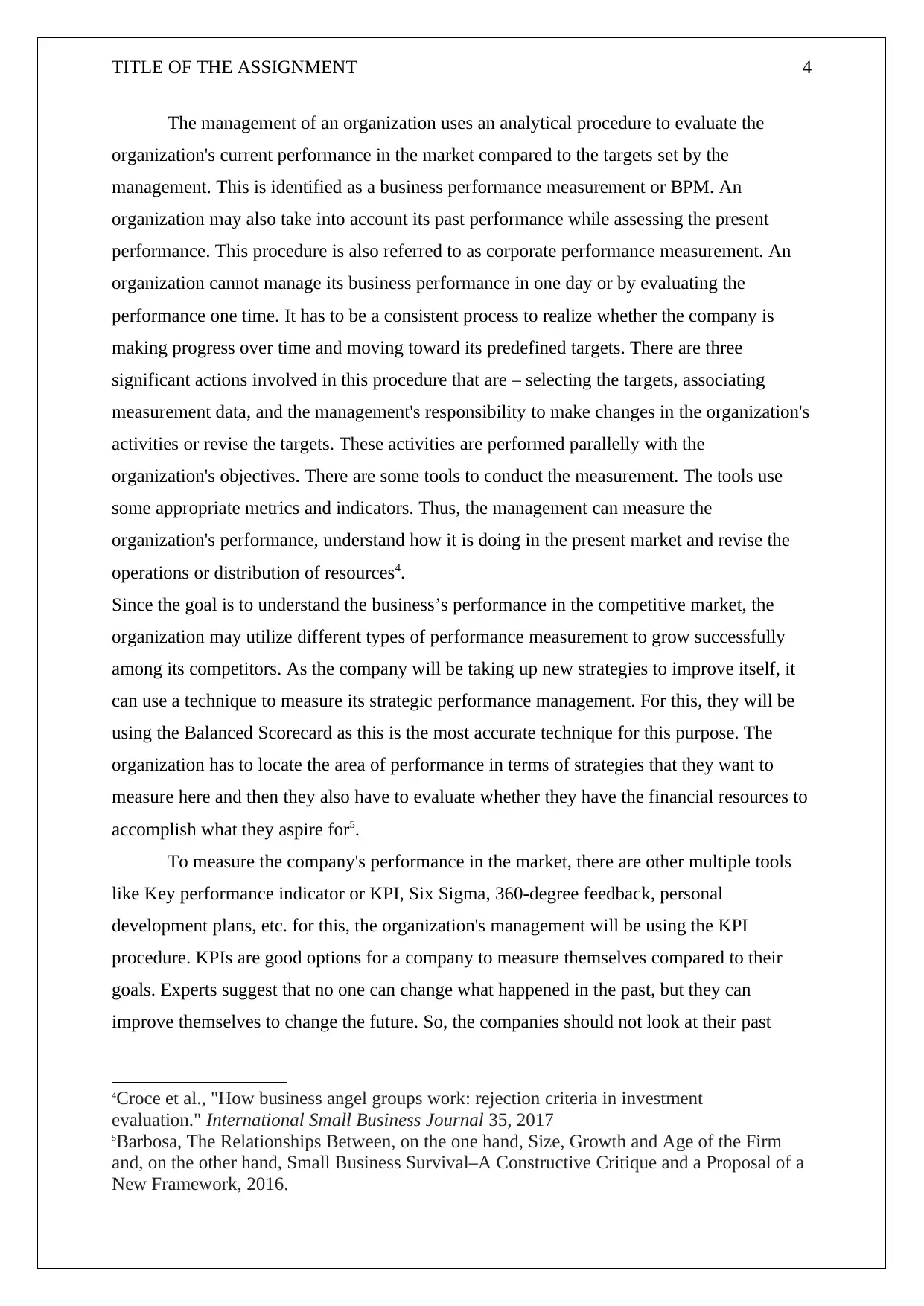
TITLE OF THE ASSIGNMENT 4
The management of an organization uses an analytical procedure to evaluate the
organization's current performance in the market compared to the targets set by the
management. This is identified as a business performance measurement or BPM. An
organization may also take into account its past performance while assessing the present
performance. This procedure is also referred to as corporate performance measurement. An
organization cannot manage its business performance in one day or by evaluating the
performance one time. It has to be a consistent process to realize whether the company is
making progress over time and moving toward its predefined targets. There are three
significant actions involved in this procedure that are – selecting the targets, associating
measurement data, and the management's responsibility to make changes in the organization's
activities or revise the targets. These activities are performed parallelly with the
organization's objectives. There are some tools to conduct the measurement. The tools use
some appropriate metrics and indicators. Thus, the management can measure the
organization's performance, understand how it is doing in the present market and revise the
operations or distribution of resources4.
Since the goal is to understand the business’s performance in the competitive market, the
organization may utilize different types of performance measurement to grow successfully
among its competitors. As the company will be taking up new strategies to improve itself, it
can use a technique to measure its strategic performance management. For this, they will be
using the Balanced Scorecard as this is the most accurate technique for this purpose. The
organization has to locate the area of performance in terms of strategies that they want to
measure here and then they also have to evaluate whether they have the financial resources to
accomplish what they aspire for5.
To measure the company's performance in the market, there are other multiple tools
like Key performance indicator or KPI, Six Sigma, 360-degree feedback, personal
development plans, etc. for this, the organization's management will be using the KPI
procedure. KPIs are good options for a company to measure themselves compared to their
goals. Experts suggest that no one can change what happened in the past, but they can
improve themselves to change the future. So, the companies should not look at their past
4Croce et al., "How business angel groups work: rejection criteria in investment
evaluation." International Small Business Journal 35, 2017
5Barbosa, The Relationships Between, on the one hand, Size, Growth and Age of the Firm
and, on the other hand, Small Business Survival–A Constructive Critique and a Proposal of a
New Framework, 2016.
The management of an organization uses an analytical procedure to evaluate the
organization's current performance in the market compared to the targets set by the
management. This is identified as a business performance measurement or BPM. An
organization may also take into account its past performance while assessing the present
performance. This procedure is also referred to as corporate performance measurement. An
organization cannot manage its business performance in one day or by evaluating the
performance one time. It has to be a consistent process to realize whether the company is
making progress over time and moving toward its predefined targets. There are three
significant actions involved in this procedure that are – selecting the targets, associating
measurement data, and the management's responsibility to make changes in the organization's
activities or revise the targets. These activities are performed parallelly with the
organization's objectives. There are some tools to conduct the measurement. The tools use
some appropriate metrics and indicators. Thus, the management can measure the
organization's performance, understand how it is doing in the present market and revise the
operations or distribution of resources4.
Since the goal is to understand the business’s performance in the competitive market, the
organization may utilize different types of performance measurement to grow successfully
among its competitors. As the company will be taking up new strategies to improve itself, it
can use a technique to measure its strategic performance management. For this, they will be
using the Balanced Scorecard as this is the most accurate technique for this purpose. The
organization has to locate the area of performance in terms of strategies that they want to
measure here and then they also have to evaluate whether they have the financial resources to
accomplish what they aspire for5.
To measure the company's performance in the market, there are other multiple tools
like Key performance indicator or KPI, Six Sigma, 360-degree feedback, personal
development plans, etc. for this, the organization's management will be using the KPI
procedure. KPIs are good options for a company to measure themselves compared to their
goals. Experts suggest that no one can change what happened in the past, but they can
improve themselves to change the future. So, the companies should not look at their past
4Croce et al., "How business angel groups work: rejection criteria in investment
evaluation." International Small Business Journal 35, 2017
5Barbosa, The Relationships Between, on the one hand, Size, Growth and Age of the Firm
and, on the other hand, Small Business Survival–A Constructive Critique and a Proposal of a
New Framework, 2016.
Paraphrase This Document
Need a fresh take? Get an instant paraphrase of this document with our AI Paraphraser
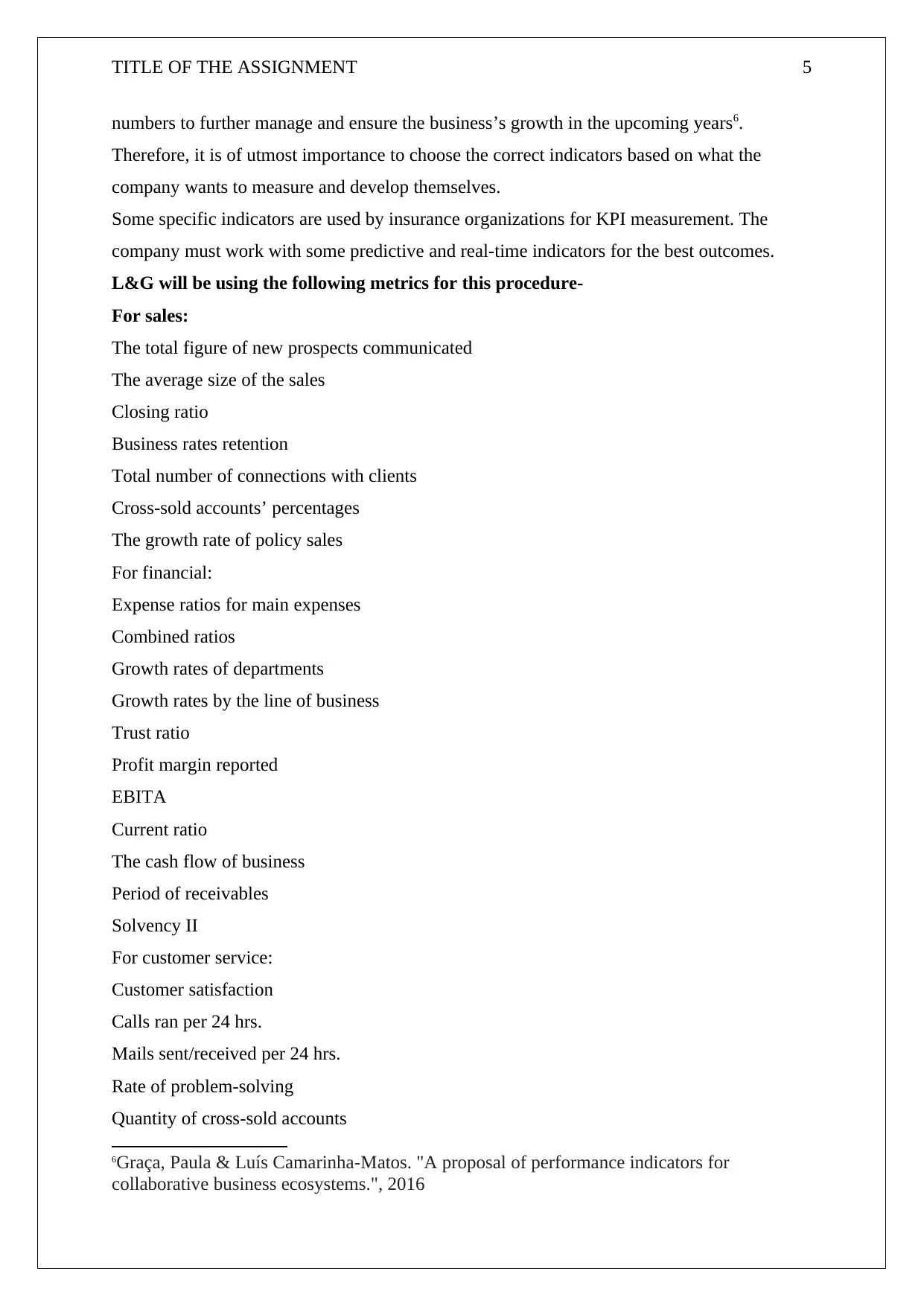
TITLE OF THE ASSIGNMENT 5
numbers to further manage and ensure the business’s growth in the upcoming years6.
Therefore, it is of utmost importance to choose the correct indicators based on what the
company wants to measure and develop themselves.
Some specific indicators are used by insurance organizations for KPI measurement. The
company must work with some predictive and real-time indicators for the best outcomes.
L&G will be using the following metrics for this procedure-
For sales:
The total figure of new prospects communicated
The average size of the sales
Closing ratio
Business rates retention
Total number of connections with clients
Cross-sold accounts’ percentages
The growth rate of policy sales
For financial:
Expense ratios for main expenses
Combined ratios
Growth rates of departments
Growth rates by the line of business
Trust ratio
Profit margin reported
EBITA
Current ratio
The cash flow of business
Period of receivables
Solvency II
For customer service:
Customer satisfaction
Calls ran per 24 hrs.
Mails sent/received per 24 hrs.
Rate of problem-solving
Quantity of cross-sold accounts
6Graça, Paula & Luís Camarinha-Matos. "A proposal of performance indicators for
collaborative business ecosystems.", 2016
numbers to further manage and ensure the business’s growth in the upcoming years6.
Therefore, it is of utmost importance to choose the correct indicators based on what the
company wants to measure and develop themselves.
Some specific indicators are used by insurance organizations for KPI measurement. The
company must work with some predictive and real-time indicators for the best outcomes.
L&G will be using the following metrics for this procedure-
For sales:
The total figure of new prospects communicated
The average size of the sales
Closing ratio
Business rates retention
Total number of connections with clients
Cross-sold accounts’ percentages
The growth rate of policy sales
For financial:
Expense ratios for main expenses
Combined ratios
Growth rates of departments
Growth rates by the line of business
Trust ratio
Profit margin reported
EBITA
Current ratio
The cash flow of business
Period of receivables
Solvency II
For customer service:
Customer satisfaction
Calls ran per 24 hrs.
Mails sent/received per 24 hrs.
Rate of problem-solving
Quantity of cross-sold accounts
6Graça, Paula & Luís Camarinha-Matos. "A proposal of performance indicators for
collaborative business ecosystems.", 2016
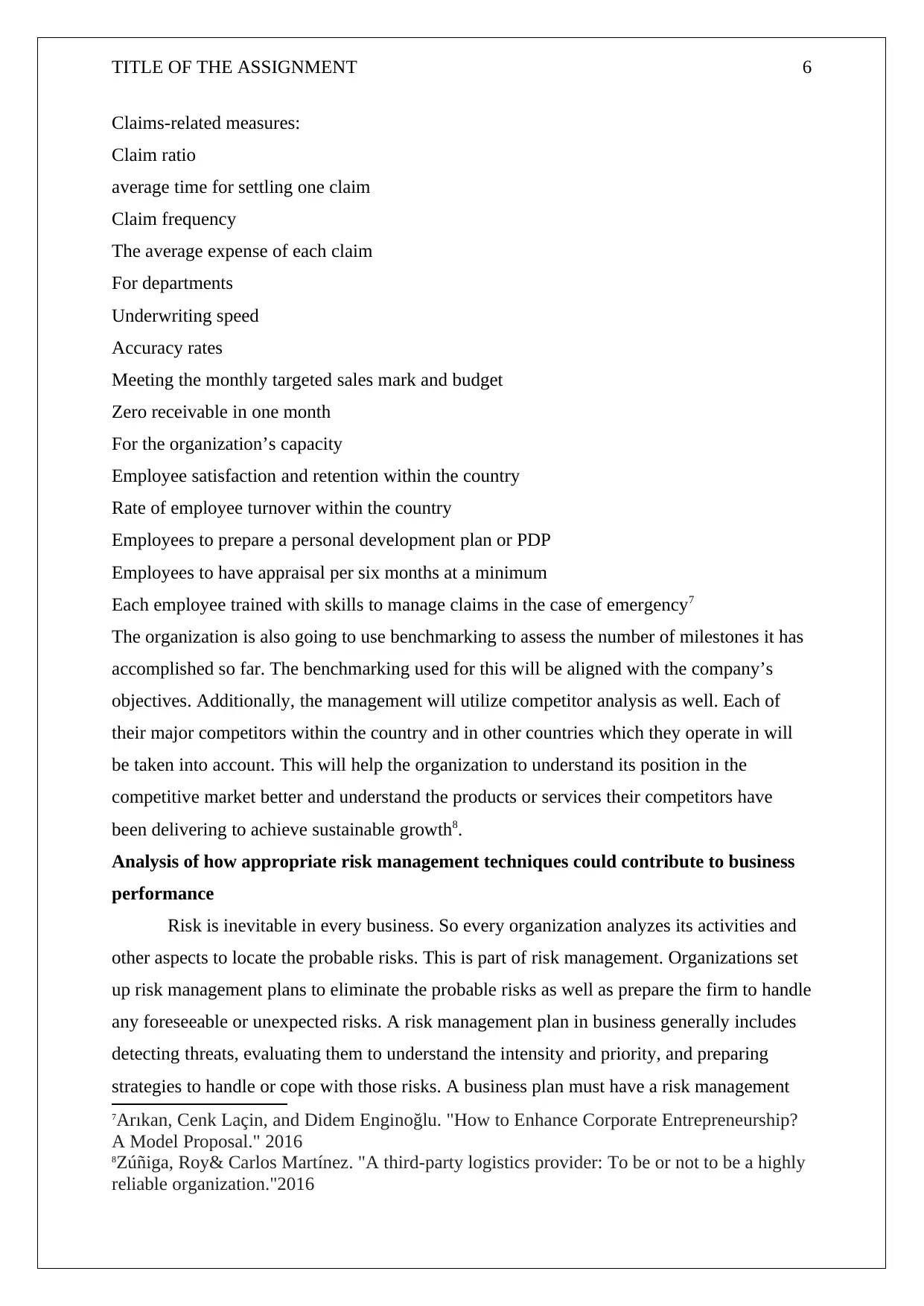
TITLE OF THE ASSIGNMENT 6
Claims-related measures:
Claim ratio
average time for settling one claim
Claim frequency
The average expense of each claim
For departments
Underwriting speed
Accuracy rates
Meeting the monthly targeted sales mark and budget
Zero receivable in one month
For the organization’s capacity
Employee satisfaction and retention within the country
Rate of employee turnover within the country
Employees to prepare a personal development plan or PDP
Employees to have appraisal per six months at a minimum
Each employee trained with skills to manage claims in the case of emergency7
The organization is also going to use benchmarking to assess the number of milestones it has
accomplished so far. The benchmarking used for this will be aligned with the company’s
objectives. Additionally, the management will utilize competitor analysis as well. Each of
their major competitors within the country and in other countries which they operate in will
be taken into account. This will help the organization to understand its position in the
competitive market better and understand the products or services their competitors have
been delivering to achieve sustainable growth8.
Analysis of how appropriate risk management techniques could contribute to business
performance
Risk is inevitable in every business. So every organization analyzes its activities and
other aspects to locate the probable risks. This is part of risk management. Organizations set
up risk management plans to eliminate the probable risks as well as prepare the firm to handle
any foreseeable or unexpected risks. A risk management plan in business generally includes
detecting threats, evaluating them to understand the intensity and priority, and preparing
strategies to handle or cope with those risks. A business plan must have a risk management
7Arıkan, Cenk Laçin, and Didem Enginoğlu. "How to Enhance Corporate Entrepreneurship?
A Model Proposal." 2016
8Zúñiga, Roy& Carlos Martínez. "A third-party logistics provider: To be or not to be a highly
reliable organization."2016
Claims-related measures:
Claim ratio
average time for settling one claim
Claim frequency
The average expense of each claim
For departments
Underwriting speed
Accuracy rates
Meeting the monthly targeted sales mark and budget
Zero receivable in one month
For the organization’s capacity
Employee satisfaction and retention within the country
Rate of employee turnover within the country
Employees to prepare a personal development plan or PDP
Employees to have appraisal per six months at a minimum
Each employee trained with skills to manage claims in the case of emergency7
The organization is also going to use benchmarking to assess the number of milestones it has
accomplished so far. The benchmarking used for this will be aligned with the company’s
objectives. Additionally, the management will utilize competitor analysis as well. Each of
their major competitors within the country and in other countries which they operate in will
be taken into account. This will help the organization to understand its position in the
competitive market better and understand the products or services their competitors have
been delivering to achieve sustainable growth8.
Analysis of how appropriate risk management techniques could contribute to business
performance
Risk is inevitable in every business. So every organization analyzes its activities and
other aspects to locate the probable risks. This is part of risk management. Organizations set
up risk management plans to eliminate the probable risks as well as prepare the firm to handle
any foreseeable or unexpected risks. A risk management plan in business generally includes
detecting threats, evaluating them to understand the intensity and priority, and preparing
strategies to handle or cope with those risks. A business plan must have a risk management
7Arıkan, Cenk Laçin, and Didem Enginoğlu. "How to Enhance Corporate Entrepreneurship?
A Model Proposal." 2016
8Zúñiga, Roy& Carlos Martínez. "A third-party logistics provider: To be or not to be a highly
reliable organization."2016
⊘ This is a preview!⊘
Do you want full access?
Subscribe today to unlock all pages.

Trusted by 1+ million students worldwide
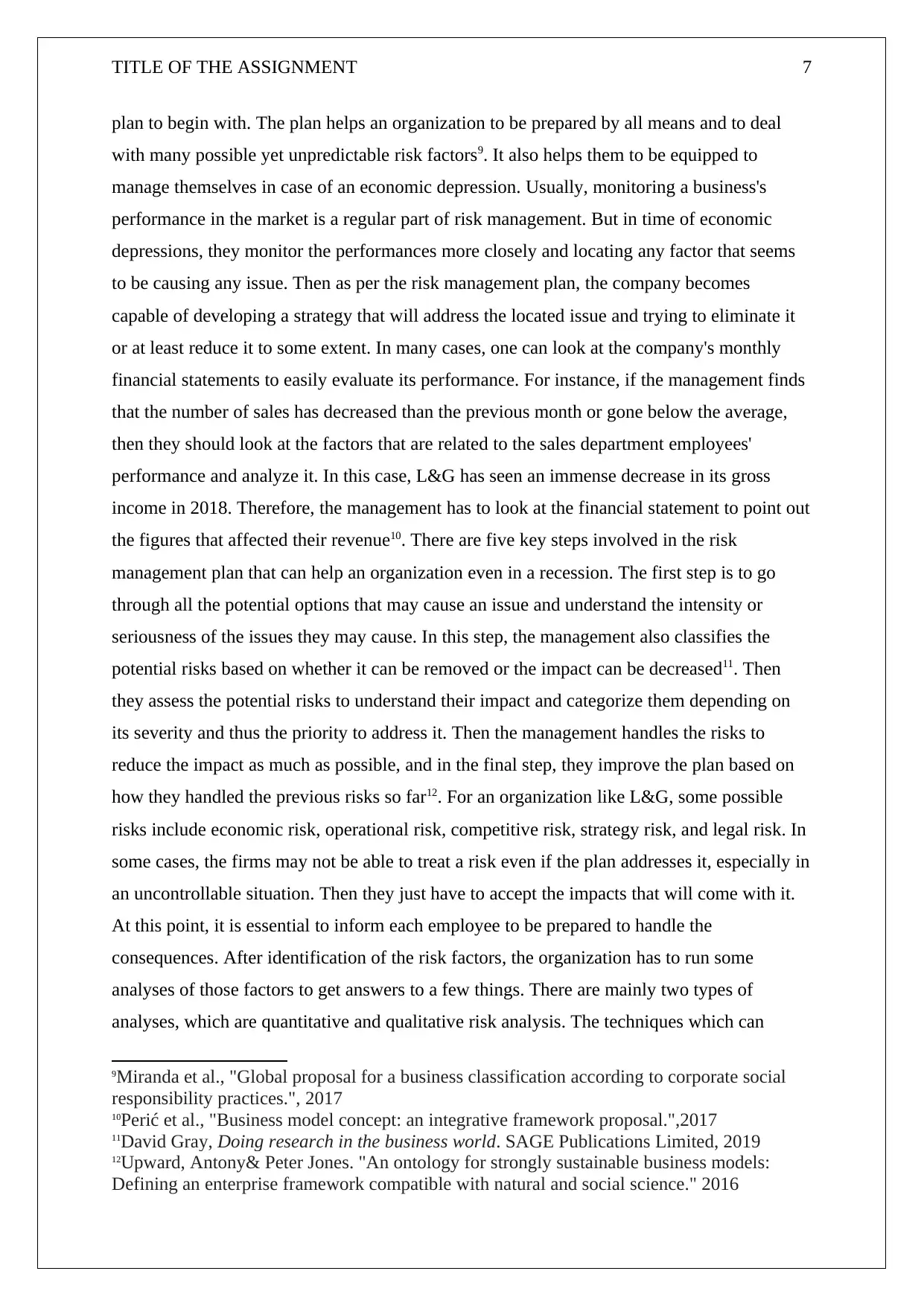
TITLE OF THE ASSIGNMENT 7
plan to begin with. The plan helps an organization to be prepared by all means and to deal
with many possible yet unpredictable risk factors9. It also helps them to be equipped to
manage themselves in case of an economic depression. Usually, monitoring a business's
performance in the market is a regular part of risk management. But in time of economic
depressions, they monitor the performances more closely and locating any factor that seems
to be causing any issue. Then as per the risk management plan, the company becomes
capable of developing a strategy that will address the located issue and trying to eliminate it
or at least reduce it to some extent. In many cases, one can look at the company's monthly
financial statements to easily evaluate its performance. For instance, if the management finds
that the number of sales has decreased than the previous month or gone below the average,
then they should look at the factors that are related to the sales department employees'
performance and analyze it. In this case, L&G has seen an immense decrease in its gross
income in 2018. Therefore, the management has to look at the financial statement to point out
the figures that affected their revenue10. There are five key steps involved in the risk
management plan that can help an organization even in a recession. The first step is to go
through all the potential options that may cause an issue and understand the intensity or
seriousness of the issues they may cause. In this step, the management also classifies the
potential risks based on whether it can be removed or the impact can be decreased11. Then
they assess the potential risks to understand their impact and categorize them depending on
its severity and thus the priority to address it. Then the management handles the risks to
reduce the impact as much as possible, and in the final step, they improve the plan based on
how they handled the previous risks so far12. For an organization like L&G, some possible
risks include economic risk, operational risk, competitive risk, strategy risk, and legal risk. In
some cases, the firms may not be able to treat a risk even if the plan addresses it, especially in
an uncontrollable situation. Then they just have to accept the impacts that will come with it.
At this point, it is essential to inform each employee to be prepared to handle the
consequences. After identification of the risk factors, the organization has to run some
analyses of those factors to get answers to a few things. There are mainly two types of
analyses, which are quantitative and qualitative risk analysis. The techniques which can
9Miranda et al., "Global proposal for a business classification according to corporate social
responsibility practices.", 2017
10Perić et al., "Business model concept: an integrative framework proposal.",2017
11David Gray, Doing research in the business world. SAGE Publications Limited, 2019
12Upward, Antony& Peter Jones. "An ontology for strongly sustainable business models:
Defining an enterprise framework compatible with natural and social science." 2016
plan to begin with. The plan helps an organization to be prepared by all means and to deal
with many possible yet unpredictable risk factors9. It also helps them to be equipped to
manage themselves in case of an economic depression. Usually, monitoring a business's
performance in the market is a regular part of risk management. But in time of economic
depressions, they monitor the performances more closely and locating any factor that seems
to be causing any issue. Then as per the risk management plan, the company becomes
capable of developing a strategy that will address the located issue and trying to eliminate it
or at least reduce it to some extent. In many cases, one can look at the company's monthly
financial statements to easily evaluate its performance. For instance, if the management finds
that the number of sales has decreased than the previous month or gone below the average,
then they should look at the factors that are related to the sales department employees'
performance and analyze it. In this case, L&G has seen an immense decrease in its gross
income in 2018. Therefore, the management has to look at the financial statement to point out
the figures that affected their revenue10. There are five key steps involved in the risk
management plan that can help an organization even in a recession. The first step is to go
through all the potential options that may cause an issue and understand the intensity or
seriousness of the issues they may cause. In this step, the management also classifies the
potential risks based on whether it can be removed or the impact can be decreased11. Then
they assess the potential risks to understand their impact and categorize them depending on
its severity and thus the priority to address it. Then the management handles the risks to
reduce the impact as much as possible, and in the final step, they improve the plan based on
how they handled the previous risks so far12. For an organization like L&G, some possible
risks include economic risk, operational risk, competitive risk, strategy risk, and legal risk. In
some cases, the firms may not be able to treat a risk even if the plan addresses it, especially in
an uncontrollable situation. Then they just have to accept the impacts that will come with it.
At this point, it is essential to inform each employee to be prepared to handle the
consequences. After identification of the risk factors, the organization has to run some
analyses of those factors to get answers to a few things. There are mainly two types of
analyses, which are quantitative and qualitative risk analysis. The techniques which can
9Miranda et al., "Global proposal for a business classification according to corporate social
responsibility practices.", 2017
10Perić et al., "Business model concept: an integrative framework proposal.",2017
11David Gray, Doing research in the business world. SAGE Publications Limited, 2019
12Upward, Antony& Peter Jones. "An ontology for strongly sustainable business models:
Defining an enterprise framework compatible with natural and social science." 2016
Paraphrase This Document
Need a fresh take? Get an instant paraphrase of this document with our AI Paraphraser
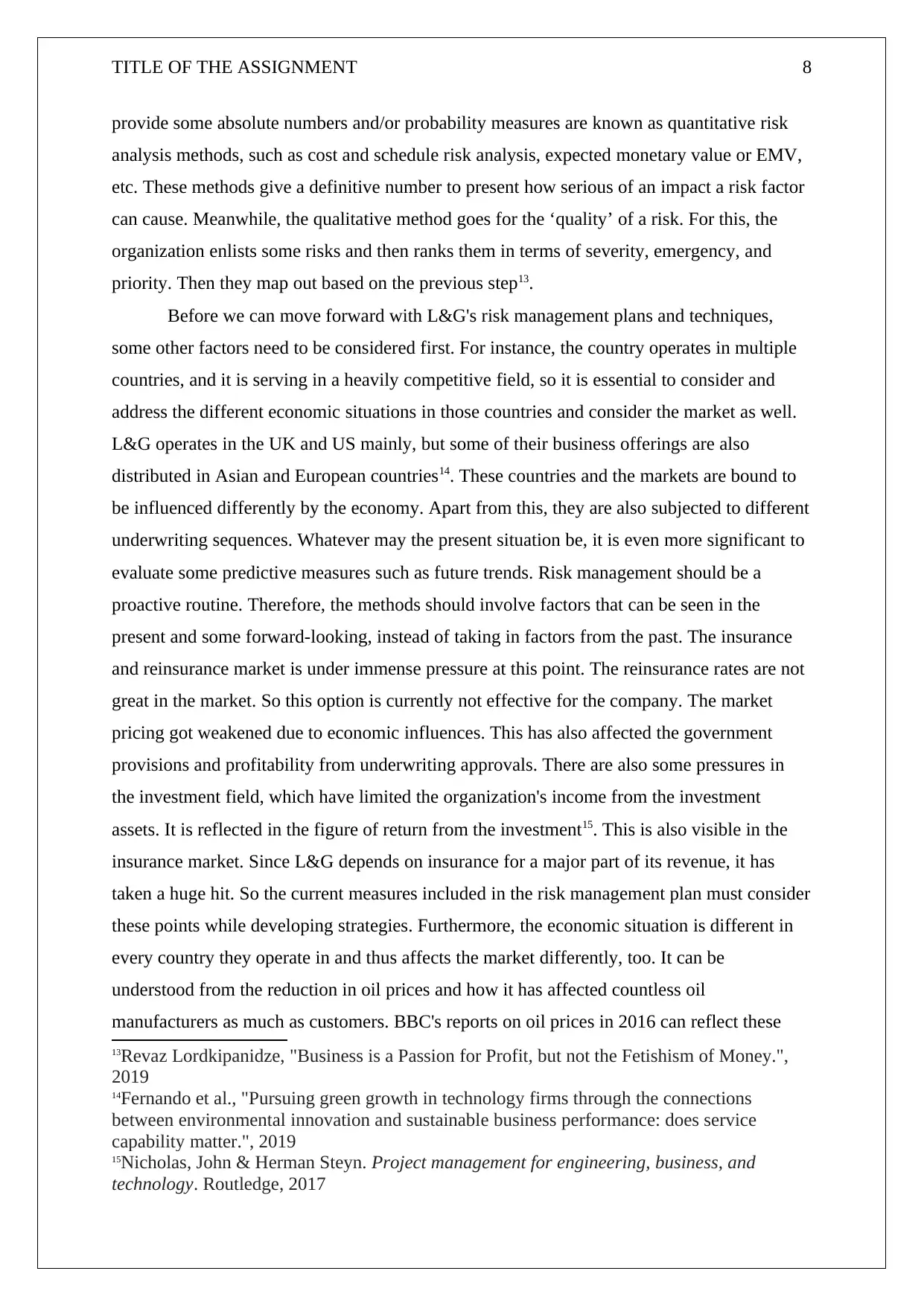
TITLE OF THE ASSIGNMENT 8
provide some absolute numbers and/or probability measures are known as quantitative risk
analysis methods, such as cost and schedule risk analysis, expected monetary value or EMV,
etc. These methods give a definitive number to present how serious of an impact a risk factor
can cause. Meanwhile, the qualitative method goes for the ‘quality’ of a risk. For this, the
organization enlists some risks and then ranks them in terms of severity, emergency, and
priority. Then they map out based on the previous step13.
Before we can move forward with L&G's risk management plans and techniques,
some other factors need to be considered first. For instance, the country operates in multiple
countries, and it is serving in a heavily competitive field, so it is essential to consider and
address the different economic situations in those countries and consider the market as well.
L&G operates in the UK and US mainly, but some of their business offerings are also
distributed in Asian and European countries14. These countries and the markets are bound to
be influenced differently by the economy. Apart from this, they are also subjected to different
underwriting sequences. Whatever may the present situation be, it is even more significant to
evaluate some predictive measures such as future trends. Risk management should be a
proactive routine. Therefore, the methods should involve factors that can be seen in the
present and some forward-looking, instead of taking in factors from the past. The insurance
and reinsurance market is under immense pressure at this point. The reinsurance rates are not
great in the market. So this option is currently not effective for the company. The market
pricing got weakened due to economic influences. This has also affected the government
provisions and profitability from underwriting approvals. There are also some pressures in
the investment field, which have limited the organization's income from the investment
assets. It is reflected in the figure of return from the investment15. This is also visible in the
insurance market. Since L&G depends on insurance for a major part of its revenue, it has
taken a huge hit. So the current measures included in the risk management plan must consider
these points while developing strategies. Furthermore, the economic situation is different in
every country they operate in and thus affects the market differently, too. It can be
understood from the reduction in oil prices and how it has affected countless oil
manufacturers as much as customers. BBC's reports on oil prices in 2016 can reflect these
13Revaz Lordkipanidze, "Business is a Passion for Profit, but not the Fetishism of Money.",
2019
14Fernando et al., "Pursuing green growth in technology firms through the connections
between environmental innovation and sustainable business performance: does service
capability matter.", 2019
15Nicholas, John & Herman Steyn. Project management for engineering, business, and
technology. Routledge, 2017
provide some absolute numbers and/or probability measures are known as quantitative risk
analysis methods, such as cost and schedule risk analysis, expected monetary value or EMV,
etc. These methods give a definitive number to present how serious of an impact a risk factor
can cause. Meanwhile, the qualitative method goes for the ‘quality’ of a risk. For this, the
organization enlists some risks and then ranks them in terms of severity, emergency, and
priority. Then they map out based on the previous step13.
Before we can move forward with L&G's risk management plans and techniques,
some other factors need to be considered first. For instance, the country operates in multiple
countries, and it is serving in a heavily competitive field, so it is essential to consider and
address the different economic situations in those countries and consider the market as well.
L&G operates in the UK and US mainly, but some of their business offerings are also
distributed in Asian and European countries14. These countries and the markets are bound to
be influenced differently by the economy. Apart from this, they are also subjected to different
underwriting sequences. Whatever may the present situation be, it is even more significant to
evaluate some predictive measures such as future trends. Risk management should be a
proactive routine. Therefore, the methods should involve factors that can be seen in the
present and some forward-looking, instead of taking in factors from the past. The insurance
and reinsurance market is under immense pressure at this point. The reinsurance rates are not
great in the market. So this option is currently not effective for the company. The market
pricing got weakened due to economic influences. This has also affected the government
provisions and profitability from underwriting approvals. There are also some pressures in
the investment field, which have limited the organization's income from the investment
assets. It is reflected in the figure of return from the investment15. This is also visible in the
insurance market. Since L&G depends on insurance for a major part of its revenue, it has
taken a huge hit. So the current measures included in the risk management plan must consider
these points while developing strategies. Furthermore, the economic situation is different in
every country they operate in and thus affects the market differently, too. It can be
understood from the reduction in oil prices and how it has affected countless oil
manufacturers as much as customers. BBC's reports on oil prices in 2016 can reflect these
13Revaz Lordkipanidze, "Business is a Passion for Profit, but not the Fetishism of Money.",
2019
14Fernando et al., "Pursuing green growth in technology firms through the connections
between environmental innovation and sustainable business performance: does service
capability matter.", 2019
15Nicholas, John & Herman Steyn. Project management for engineering, business, and
technology. Routledge, 2017
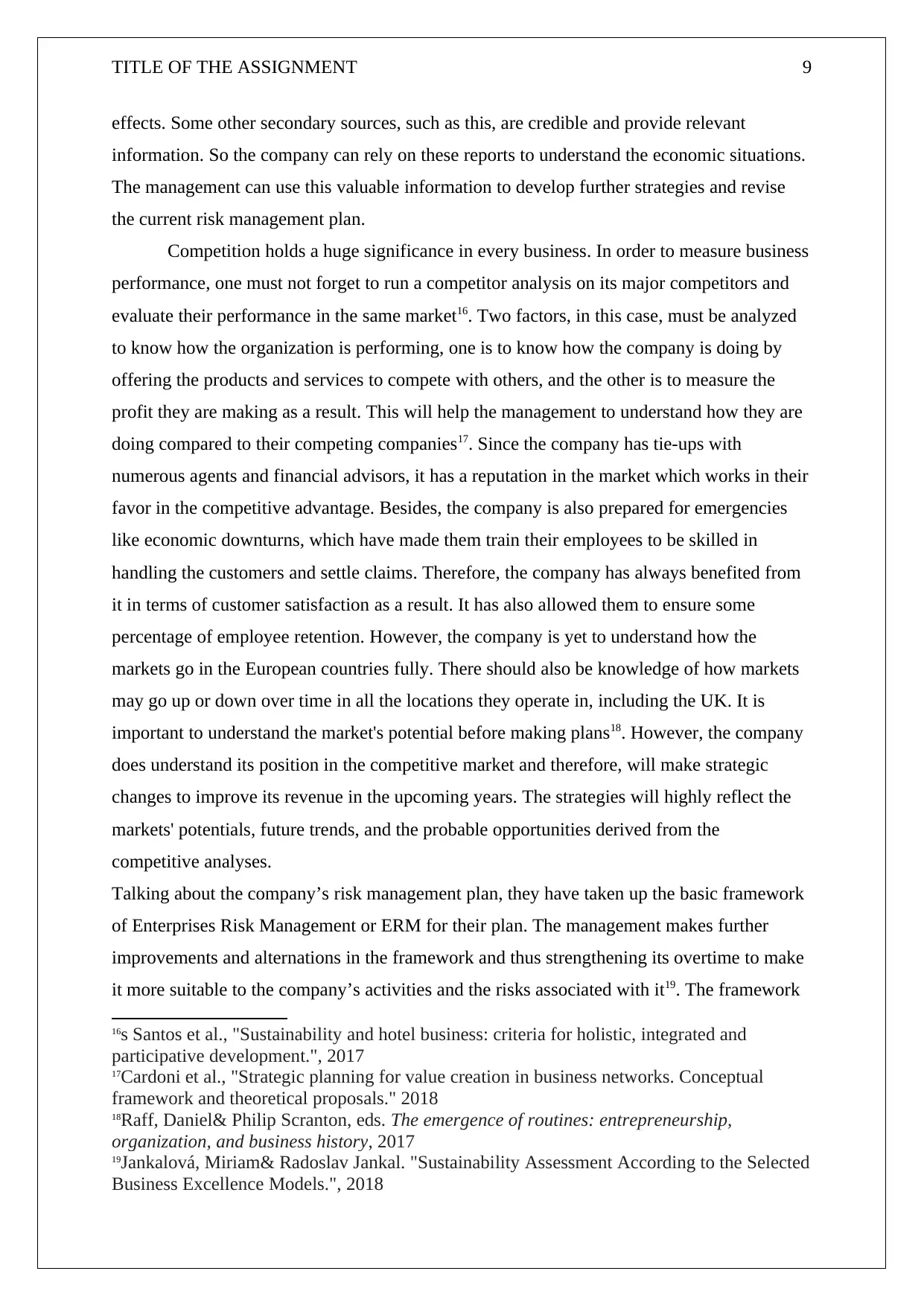
TITLE OF THE ASSIGNMENT 9
effects. Some other secondary sources, such as this, are credible and provide relevant
information. So the company can rely on these reports to understand the economic situations.
The management can use this valuable information to develop further strategies and revise
the current risk management plan.
Competition holds a huge significance in every business. In order to measure business
performance, one must not forget to run a competitor analysis on its major competitors and
evaluate their performance in the same market16. Two factors, in this case, must be analyzed
to know how the organization is performing, one is to know how the company is doing by
offering the products and services to compete with others, and the other is to measure the
profit they are making as a result. This will help the management to understand how they are
doing compared to their competing companies17. Since the company has tie-ups with
numerous agents and financial advisors, it has a reputation in the market which works in their
favor in the competitive advantage. Besides, the company is also prepared for emergencies
like economic downturns, which have made them train their employees to be skilled in
handling the customers and settle claims. Therefore, the company has always benefited from
it in terms of customer satisfaction as a result. It has also allowed them to ensure some
percentage of employee retention. However, the company is yet to understand how the
markets go in the European countries fully. There should also be knowledge of how markets
may go up or down over time in all the locations they operate in, including the UK. It is
important to understand the market's potential before making plans18. However, the company
does understand its position in the competitive market and therefore, will make strategic
changes to improve its revenue in the upcoming years. The strategies will highly reflect the
markets' potentials, future trends, and the probable opportunities derived from the
competitive analyses.
Talking about the company’s risk management plan, they have taken up the basic framework
of Enterprises Risk Management or ERM for their plan. The management makes further
improvements and alternations in the framework and thus strengthening its overtime to make
it more suitable to the company’s activities and the risks associated with it19. The framework
16s Santos et al., "Sustainability and hotel business: criteria for holistic, integrated and
participative development.", 2017
17Cardoni et al., "Strategic planning for value creation in business networks. Conceptual
framework and theoretical proposals." 2018
18Raff, Daniel& Philip Scranton, eds. The emergence of routines: entrepreneurship,
organization, and business history, 2017
19Jankalová, Miriam& Radoslav Jankal. "Sustainability Assessment According to the Selected
Business Excellence Models.", 2018
effects. Some other secondary sources, such as this, are credible and provide relevant
information. So the company can rely on these reports to understand the economic situations.
The management can use this valuable information to develop further strategies and revise
the current risk management plan.
Competition holds a huge significance in every business. In order to measure business
performance, one must not forget to run a competitor analysis on its major competitors and
evaluate their performance in the same market16. Two factors, in this case, must be analyzed
to know how the organization is performing, one is to know how the company is doing by
offering the products and services to compete with others, and the other is to measure the
profit they are making as a result. This will help the management to understand how they are
doing compared to their competing companies17. Since the company has tie-ups with
numerous agents and financial advisors, it has a reputation in the market which works in their
favor in the competitive advantage. Besides, the company is also prepared for emergencies
like economic downturns, which have made them train their employees to be skilled in
handling the customers and settle claims. Therefore, the company has always benefited from
it in terms of customer satisfaction as a result. It has also allowed them to ensure some
percentage of employee retention. However, the company is yet to understand how the
markets go in the European countries fully. There should also be knowledge of how markets
may go up or down over time in all the locations they operate in, including the UK. It is
important to understand the market's potential before making plans18. However, the company
does understand its position in the competitive market and therefore, will make strategic
changes to improve its revenue in the upcoming years. The strategies will highly reflect the
markets' potentials, future trends, and the probable opportunities derived from the
competitive analyses.
Talking about the company’s risk management plan, they have taken up the basic framework
of Enterprises Risk Management or ERM for their plan. The management makes further
improvements and alternations in the framework and thus strengthening its overtime to make
it more suitable to the company’s activities and the risks associated with it19. The framework
16s Santos et al., "Sustainability and hotel business: criteria for holistic, integrated and
participative development.", 2017
17Cardoni et al., "Strategic planning for value creation in business networks. Conceptual
framework and theoretical proposals." 2018
18Raff, Daniel& Philip Scranton, eds. The emergence of routines: entrepreneurship,
organization, and business history, 2017
19Jankalová, Miriam& Radoslav Jankal. "Sustainability Assessment According to the Selected
Business Excellence Models.", 2018
⊘ This is a preview!⊘
Do you want full access?
Subscribe today to unlock all pages.

Trusted by 1+ million students worldwide
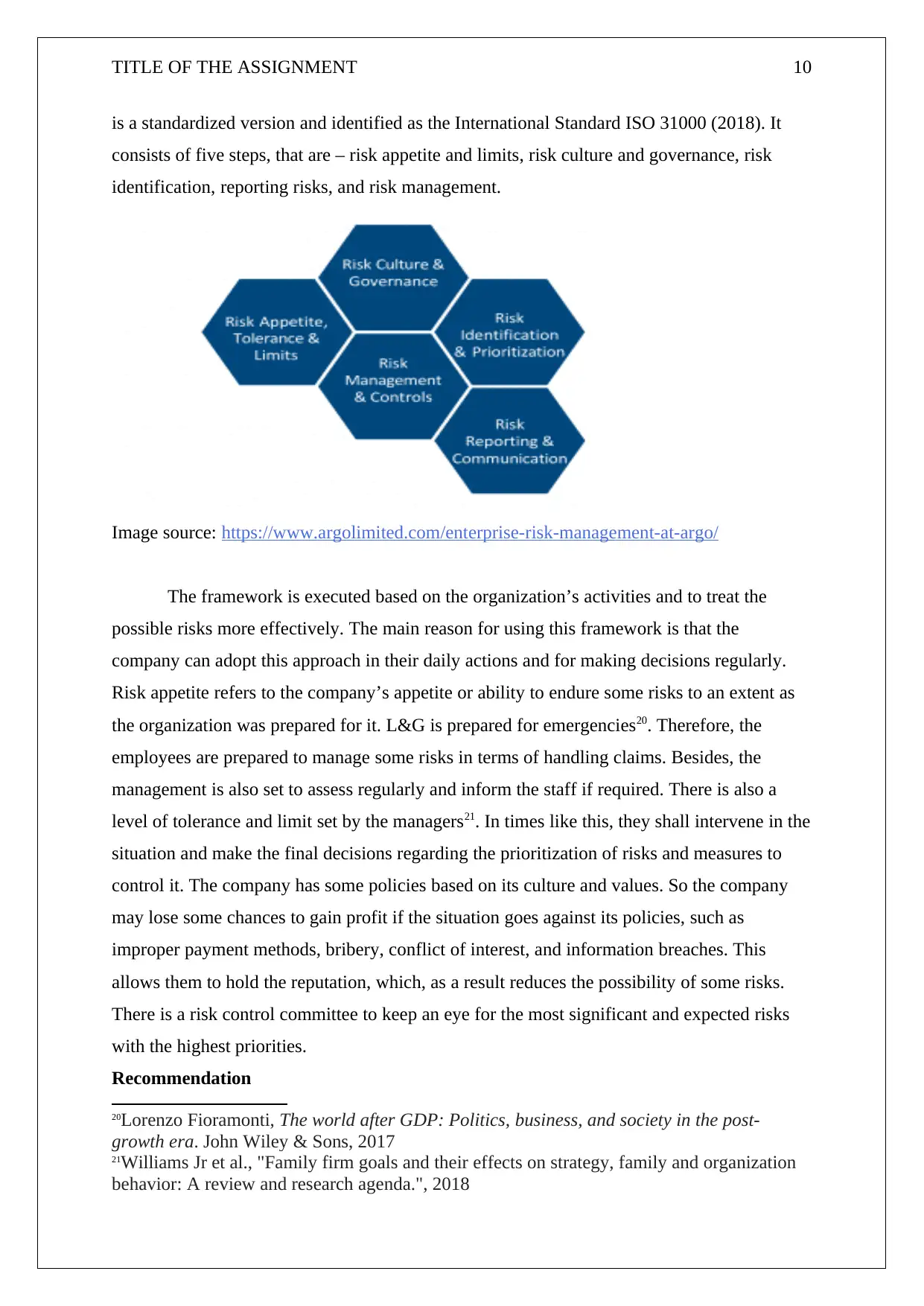
TITLE OF THE ASSIGNMENT 10
is a standardized version and identified as the International Standard ISO 31000 (2018). It
consists of five steps, that are – risk appetite and limits, risk culture and governance, risk
identification, reporting risks, and risk management.
Image source: https://www.argolimited.com/enterprise-risk-management-at-argo/
The framework is executed based on the organization’s activities and to treat the
possible risks more effectively. The main reason for using this framework is that the
company can adopt this approach in their daily actions and for making decisions regularly.
Risk appetite refers to the company’s appetite or ability to endure some risks to an extent as
the organization was prepared for it. L&G is prepared for emergencies20. Therefore, the
employees are prepared to manage some risks in terms of handling claims. Besides, the
management is also set to assess regularly and inform the staff if required. There is also a
level of tolerance and limit set by the managers21. In times like this, they shall intervene in the
situation and make the final decisions regarding the prioritization of risks and measures to
control it. The company has some policies based on its culture and values. So the company
may lose some chances to gain profit if the situation goes against its policies, such as
improper payment methods, bribery, conflict of interest, and information breaches. This
allows them to hold the reputation, which, as a result reduces the possibility of some risks.
There is a risk control committee to keep an eye for the most significant and expected risks
with the highest priorities.
Recommendation
20Lorenzo Fioramonti, The world after GDP: Politics, business, and society in the post-
growth era. John Wiley & Sons, 2017
21Williams Jr et al., "Family firm goals and their effects on strategy, family and organization
behavior: A review and research agenda.", 2018
is a standardized version and identified as the International Standard ISO 31000 (2018). It
consists of five steps, that are – risk appetite and limits, risk culture and governance, risk
identification, reporting risks, and risk management.
Image source: https://www.argolimited.com/enterprise-risk-management-at-argo/
The framework is executed based on the organization’s activities and to treat the
possible risks more effectively. The main reason for using this framework is that the
company can adopt this approach in their daily actions and for making decisions regularly.
Risk appetite refers to the company’s appetite or ability to endure some risks to an extent as
the organization was prepared for it. L&G is prepared for emergencies20. Therefore, the
employees are prepared to manage some risks in terms of handling claims. Besides, the
management is also set to assess regularly and inform the staff if required. There is also a
level of tolerance and limit set by the managers21. In times like this, they shall intervene in the
situation and make the final decisions regarding the prioritization of risks and measures to
control it. The company has some policies based on its culture and values. So the company
may lose some chances to gain profit if the situation goes against its policies, such as
improper payment methods, bribery, conflict of interest, and information breaches. This
allows them to hold the reputation, which, as a result reduces the possibility of some risks.
There is a risk control committee to keep an eye for the most significant and expected risks
with the highest priorities.
Recommendation
20Lorenzo Fioramonti, The world after GDP: Politics, business, and society in the post-
growth era. John Wiley & Sons, 2017
21Williams Jr et al., "Family firm goals and their effects on strategy, family and organization
behavior: A review and research agenda.", 2018
Paraphrase This Document
Need a fresh take? Get an instant paraphrase of this document with our AI Paraphraser
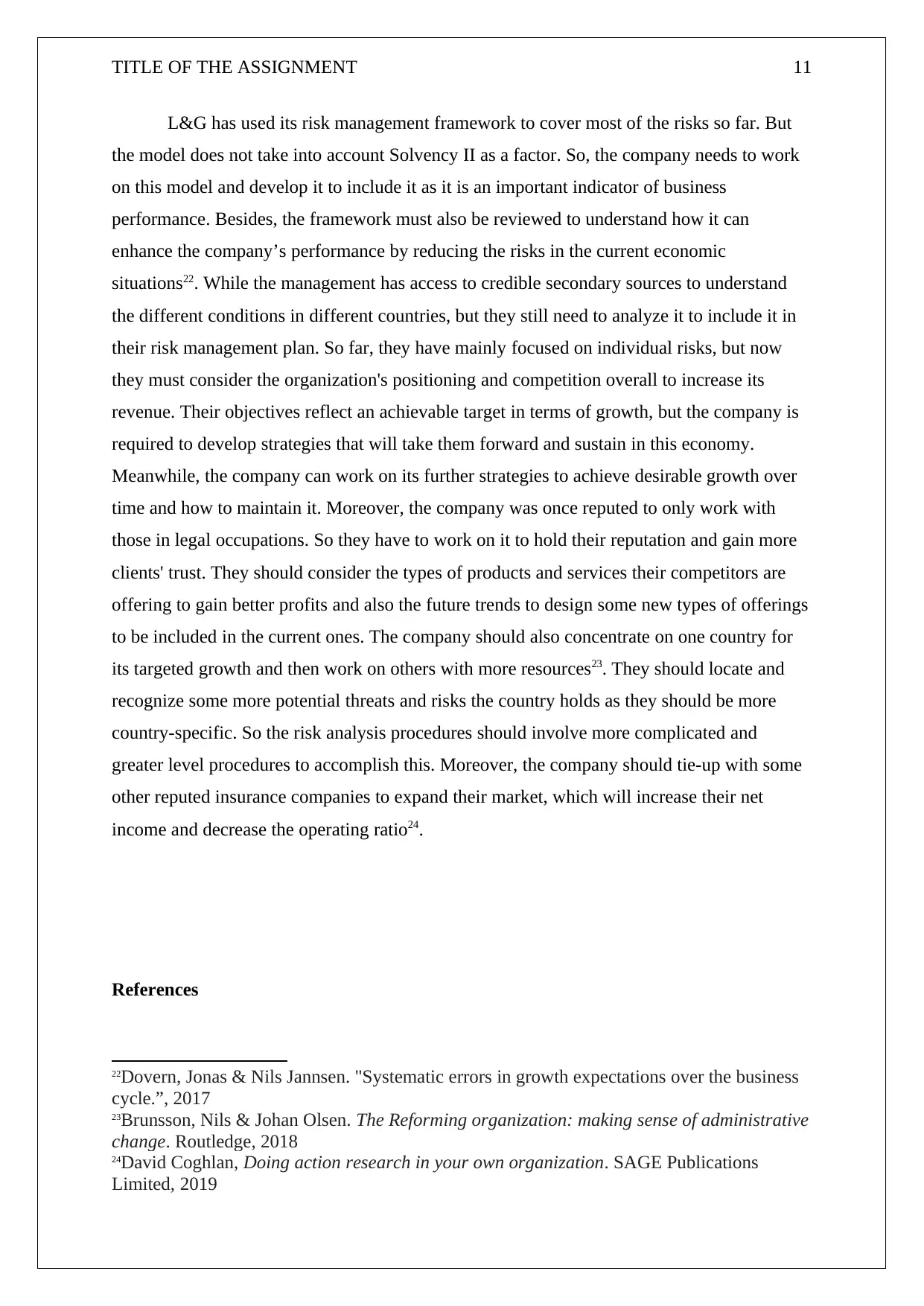
TITLE OF THE ASSIGNMENT 11
L&G has used its risk management framework to cover most of the risks so far. But
the model does not take into account Solvency II as a factor. So, the company needs to work
on this model and develop it to include it as it is an important indicator of business
performance. Besides, the framework must also be reviewed to understand how it can
enhance the company’s performance by reducing the risks in the current economic
situations22. While the management has access to credible secondary sources to understand
the different conditions in different countries, but they still need to analyze it to include it in
their risk management plan. So far, they have mainly focused on individual risks, but now
they must consider the organization's positioning and competition overall to increase its
revenue. Their objectives reflect an achievable target in terms of growth, but the company is
required to develop strategies that will take them forward and sustain in this economy.
Meanwhile, the company can work on its further strategies to achieve desirable growth over
time and how to maintain it. Moreover, the company was once reputed to only work with
those in legal occupations. So they have to work on it to hold their reputation and gain more
clients' trust. They should consider the types of products and services their competitors are
offering to gain better profits and also the future trends to design some new types of offerings
to be included in the current ones. The company should also concentrate on one country for
its targeted growth and then work on others with more resources23. They should locate and
recognize some more potential threats and risks the country holds as they should be more
country-specific. So the risk analysis procedures should involve more complicated and
greater level procedures to accomplish this. Moreover, the company should tie-up with some
other reputed insurance companies to expand their market, which will increase their net
income and decrease the operating ratio24.
References
22Dovern, Jonas & Nils Jannsen. "Systematic errors in growth expectations over the business
cycle.”, 2017
23Brunsson, Nils & Johan Olsen. The Reforming organization: making sense of administrative
change. Routledge, 2018
24David Coghlan, Doing action research in your own organization. SAGE Publications
Limited, 2019
L&G has used its risk management framework to cover most of the risks so far. But
the model does not take into account Solvency II as a factor. So, the company needs to work
on this model and develop it to include it as it is an important indicator of business
performance. Besides, the framework must also be reviewed to understand how it can
enhance the company’s performance by reducing the risks in the current economic
situations22. While the management has access to credible secondary sources to understand
the different conditions in different countries, but they still need to analyze it to include it in
their risk management plan. So far, they have mainly focused on individual risks, but now
they must consider the organization's positioning and competition overall to increase its
revenue. Their objectives reflect an achievable target in terms of growth, but the company is
required to develop strategies that will take them forward and sustain in this economy.
Meanwhile, the company can work on its further strategies to achieve desirable growth over
time and how to maintain it. Moreover, the company was once reputed to only work with
those in legal occupations. So they have to work on it to hold their reputation and gain more
clients' trust. They should consider the types of products and services their competitors are
offering to gain better profits and also the future trends to design some new types of offerings
to be included in the current ones. The company should also concentrate on one country for
its targeted growth and then work on others with more resources23. They should locate and
recognize some more potential threats and risks the country holds as they should be more
country-specific. So the risk analysis procedures should involve more complicated and
greater level procedures to accomplish this. Moreover, the company should tie-up with some
other reputed insurance companies to expand their market, which will increase their net
income and decrease the operating ratio24.
References
22Dovern, Jonas & Nils Jannsen. "Systematic errors in growth expectations over the business
cycle.”, 2017
23Brunsson, Nils & Johan Olsen. The Reforming organization: making sense of administrative
change. Routledge, 2018
24David Coghlan, Doing action research in your own organization. SAGE Publications
Limited, 2019
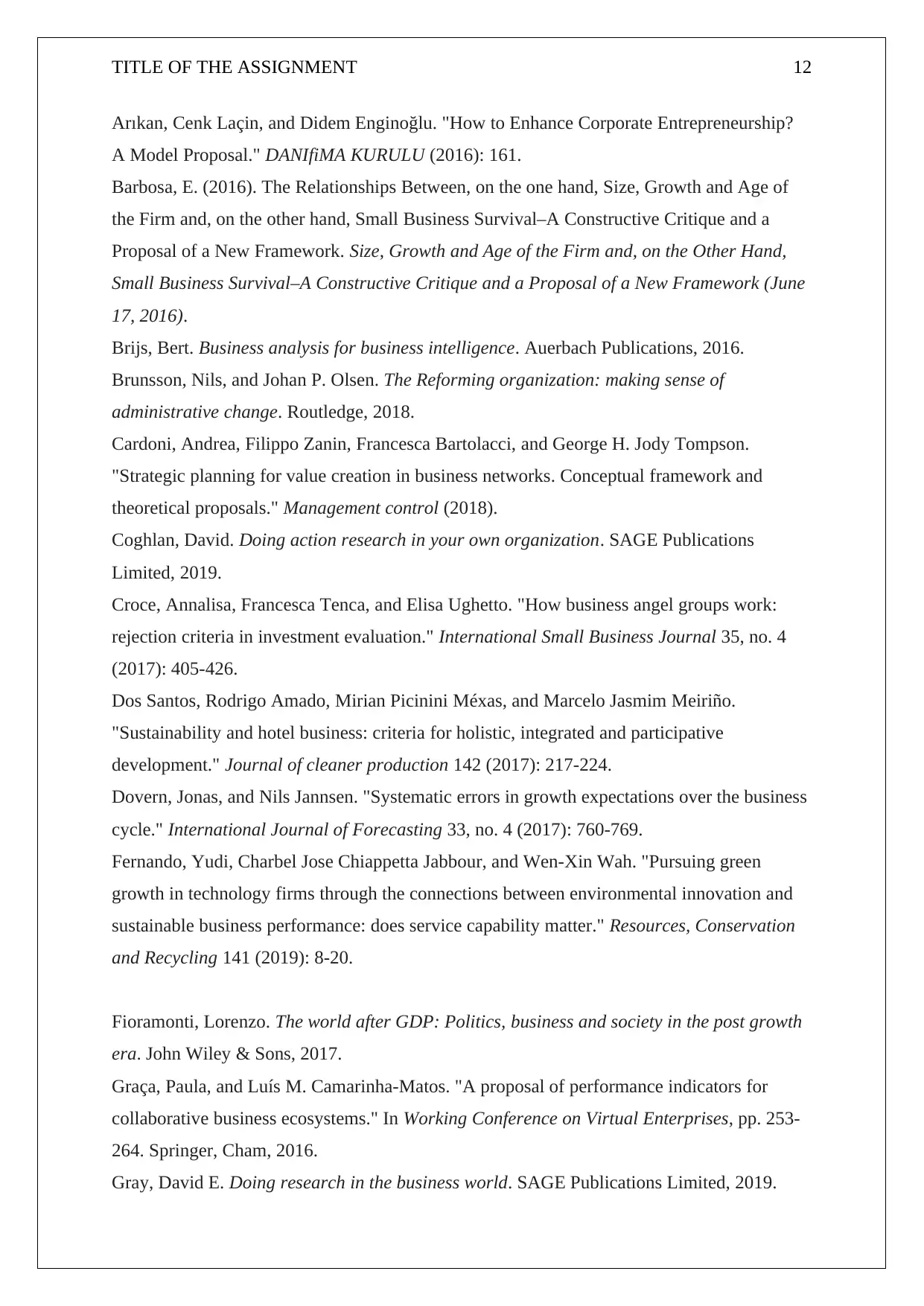
TITLE OF THE ASSIGNMENT 12
Arıkan, Cenk Laçin, and Didem Enginoğlu. "How to Enhance Corporate Entrepreneurship?
A Model Proposal." DANIfiMA KURULU (2016): 161.
Barbosa, E. (2016). The Relationships Between, on the one hand, Size, Growth and Age of
the Firm and, on the other hand, Small Business Survival–A Constructive Critique and a
Proposal of a New Framework. Size, Growth and Age of the Firm and, on the Other Hand,
Small Business Survival–A Constructive Critique and a Proposal of a New Framework (June
17, 2016).
Brijs, Bert. Business analysis for business intelligence. Auerbach Publications, 2016.
Brunsson, Nils, and Johan P. Olsen. The Reforming organization: making sense of
administrative change. Routledge, 2018.
Cardoni, Andrea, Filippo Zanin, Francesca Bartolacci, and George H. Jody Tompson.
"Strategic planning for value creation in business networks. Conceptual framework and
theoretical proposals." Management control (2018).
Coghlan, David. Doing action research in your own organization. SAGE Publications
Limited, 2019.
Croce, Annalisa, Francesca Tenca, and Elisa Ughetto. "How business angel groups work:
rejection criteria in investment evaluation." International Small Business Journal 35, no. 4
(2017): 405-426.
Dos Santos, Rodrigo Amado, Mirian Picinini Méxas, and Marcelo Jasmim Meiriño.
"Sustainability and hotel business: criteria for holistic, integrated and participative
development." Journal of cleaner production 142 (2017): 217-224.
Dovern, Jonas, and Nils Jannsen. "Systematic errors in growth expectations over the business
cycle." International Journal of Forecasting 33, no. 4 (2017): 760-769.
Fernando, Yudi, Charbel Jose Chiappetta Jabbour, and Wen-Xin Wah. "Pursuing green
growth in technology firms through the connections between environmental innovation and
sustainable business performance: does service capability matter." Resources, Conservation
and Recycling 141 (2019): 8-20.
Fioramonti, Lorenzo. The world after GDP: Politics, business and society in the post growth
era. John Wiley & Sons, 2017.
Graça, Paula, and Luís M. Camarinha-Matos. "A proposal of performance indicators for
collaborative business ecosystems." In Working Conference on Virtual Enterprises, pp. 253-
264. Springer, Cham, 2016.
Gray, David E. Doing research in the business world. SAGE Publications Limited, 2019.
Arıkan, Cenk Laçin, and Didem Enginoğlu. "How to Enhance Corporate Entrepreneurship?
A Model Proposal." DANIfiMA KURULU (2016): 161.
Barbosa, E. (2016). The Relationships Between, on the one hand, Size, Growth and Age of
the Firm and, on the other hand, Small Business Survival–A Constructive Critique and a
Proposal of a New Framework. Size, Growth and Age of the Firm and, on the Other Hand,
Small Business Survival–A Constructive Critique and a Proposal of a New Framework (June
17, 2016).
Brijs, Bert. Business analysis for business intelligence. Auerbach Publications, 2016.
Brunsson, Nils, and Johan P. Olsen. The Reforming organization: making sense of
administrative change. Routledge, 2018.
Cardoni, Andrea, Filippo Zanin, Francesca Bartolacci, and George H. Jody Tompson.
"Strategic planning for value creation in business networks. Conceptual framework and
theoretical proposals." Management control (2018).
Coghlan, David. Doing action research in your own organization. SAGE Publications
Limited, 2019.
Croce, Annalisa, Francesca Tenca, and Elisa Ughetto. "How business angel groups work:
rejection criteria in investment evaluation." International Small Business Journal 35, no. 4
(2017): 405-426.
Dos Santos, Rodrigo Amado, Mirian Picinini Méxas, and Marcelo Jasmim Meiriño.
"Sustainability and hotel business: criteria for holistic, integrated and participative
development." Journal of cleaner production 142 (2017): 217-224.
Dovern, Jonas, and Nils Jannsen. "Systematic errors in growth expectations over the business
cycle." International Journal of Forecasting 33, no. 4 (2017): 760-769.
Fernando, Yudi, Charbel Jose Chiappetta Jabbour, and Wen-Xin Wah. "Pursuing green
growth in technology firms through the connections between environmental innovation and
sustainable business performance: does service capability matter." Resources, Conservation
and Recycling 141 (2019): 8-20.
Fioramonti, Lorenzo. The world after GDP: Politics, business and society in the post growth
era. John Wiley & Sons, 2017.
Graça, Paula, and Luís M. Camarinha-Matos. "A proposal of performance indicators for
collaborative business ecosystems." In Working Conference on Virtual Enterprises, pp. 253-
264. Springer, Cham, 2016.
Gray, David E. Doing research in the business world. SAGE Publications Limited, 2019.
⊘ This is a preview!⊘
Do you want full access?
Subscribe today to unlock all pages.

Trusted by 1+ million students worldwide
1 out of 13
Related Documents
Your All-in-One AI-Powered Toolkit for Academic Success.
+13062052269
info@desklib.com
Available 24*7 on WhatsApp / Email
![[object Object]](/_next/static/media/star-bottom.7253800d.svg)
Unlock your academic potential
Copyright © 2020–2025 A2Z Services. All Rights Reserved. Developed and managed by ZUCOL.





